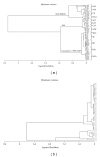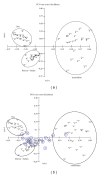Human leukocyte antigen profiles of latin american populations: differential admixture and its potential impact on hematopoietic stem cell transplantation
- PMID: 23213535
- PMCID: PMC3506882
- DOI: 10.1155/2012/136087
Human leukocyte antigen profiles of latin american populations: differential admixture and its potential impact on hematopoietic stem cell transplantation
Abstract
The outcome of hematopoietic stem cell transplantation (HSCT) is shaped by both clinical and genetic factors that determine its success. Genetic factors including human leukocyte antigen (HLA) and non-HLA genetic variants are believed to influence the risk of potentially fatal complications after the transplant. Moreover, ethnicity has been proposed as a factor modifying the risk of graft-versus-host disease. The populations of Latin America are a complex array of different admixture processes with varying degrees of ancestral population proportions that came in different migration waves. This complexity makes the study of genetic risks in this region complicated unless the extent of this variation is thoroughly characterized. In this study we compared the HLA-A and HLA-B allele group profiles for 31 Latin American populations and 61 ancestral populations from Iberia, Italy, Sub-Saharan Africa, and America. Results from population genetics comparisons show a wide variation in the HLA profiles from the Latin American populations that correlate with different admixture proportions. Populations in Latin America seem to be organized in at least three groups with (1) strong Amerindian admixture, (2) strong Caucasian component, and (3) a Caucasian-African gradient. These results imply that genetic risk assessment for HSCT in Latin America has to be adapted for different population subgroups rather than as a pan-Hispanic/Latino analysis.
Figures




Similar articles
-
High-resolution HLA allele and haplotype frequencies in majority and minority populations of Costa Rica and Nicaragua: Differential admixture proportions in neighboring countries.HLA. 2018 Jun;91(6):514-529. doi: 10.1111/tan.13280. HLA. 2018. PMID: 29687625
-
HLA concordance between hematopoietic stem cell transplantation patients and umbilical cord blood units: Implications for cord blood banking in admixed populations.Hum Immunol. 2019 Sep;80(9):714-722. doi: 10.1016/j.humimm.2019.05.002. Epub 2019 May 14. Hum Immunol. 2019. PMID: 31101373
-
Population Diversity in Pharmacogenetics: A Latin American Perspective.Adv Pharmacol. 2018;83:133-154. doi: 10.1016/bs.apha.2018.02.001. Epub 2018 Mar 19. Adv Pharmacol. 2018. PMID: 29801573 Review.
-
Differential admixture, human leukocyte antigen diversity, and hematopoietic cell transplantation in Latin America: challenges and opportunities.Bone Marrow Transplant. 2020 Mar;55(3):496-504. doi: 10.1038/s41409-019-0737-4. Epub 2019 Nov 6. Bone Marrow Transplant. 2020. PMID: 31695172 Review. No abstract available.
-
The Latin American Epidemiology Network for ALS (Laenals).Amyotroph Lateral Scler Frontotemporal Degener. 2022 Aug;23(5-6):372-377. doi: 10.1080/21678421.2022.2028168. Epub 2022 Jan 21. Amyotroph Lateral Scler Frontotemporal Degener. 2022. PMID: 35060421
Cited by
-
The association between HLA and non-Hodgkin lymphoma subtypes, among a transplant-indicated population.Leuk Lymphoma. 2019 Dec;60(12):2899-2908. doi: 10.1080/10428194.2019.1617858. Epub 2019 Jun 19. Leuk Lymphoma. 2019. PMID: 31215275 Free PMC article.
-
Immunoinformatics design of a structural proteins driven multi-epitope candidate vaccine against different SARS-CoV-2 variants based on fynomer.Sci Rep. 2024 May 4;14(1):10297. doi: 10.1038/s41598-024-61025-2. Sci Rep. 2024. PMID: 38704475 Free PMC article.
-
Poor performance of anti-mitochondrial antibodies for the diagnosis of primary biliary cholangitis in female Colombian patients: A single-center study.World J Gastroenterol. 2021 Aug 7;27(29):4890-4899. doi: 10.3748/wjg.v27.i29.4890. World J Gastroenterol. 2021. PMID: 34447233 Free PMC article.
-
An HLA map of the world: A comparison of HLA frequencies in 200 worldwide populations reveals diverse patterns for class I and class II.Front Genet. 2023 Mar 23;14:866407. doi: 10.3389/fgene.2023.866407. eCollection 2023. Front Genet. 2023. PMID: 37035735 Free PMC article.
-
Diversity of HLA Class I and Class II blocks and conserved extended haplotypes in Lacandon Mayans.Sci Rep. 2020 Feb 24;10(1):3248. doi: 10.1038/s41598-020-58897-5. Sci Rep. 2020. PMID: 32094421 Free PMC article.
References
-
- Ljungman P, Bregni M, Brune M, et al. Allogeneic and autologous transplantation for haematological diseases, solid tumours and immune disorders: current practice in Europe 2009. Bone Marrow Transplantation. 2010;45(2):219–234. - PubMed
-
- Dickinson AM. Risk assessment in haematopoietic stem cell transplantation: pre-transplant patient and donor factors: non-HLA genetics. Best Practice and Research: Clinical Haematology. 2007;20(2):189–207. - PubMed
-
- Lee SJ, Klein J, Haagenson M, et al. High-resolution donor-recipient HLA matching contributes to the success of unrelated donor marrow transplantation. Blood. 2007;110(13):4576–4583. - PubMed
-
- Shaw BE, Arguello R, Garcia-Sepulveda CA, Madrigal JA. The impact of HLA genotyping on survival following unrelated donor haematopoietic stem cell transplantation: review. British Journal of Haematology. 2010;150(3):251–258. - PubMed
LinkOut - more resources
Full Text Sources
Research Materials

